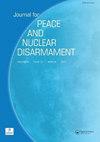Chemical and Biological Weapons in Regional Disarmament in the Middle East and North Africa
IF 1.4
Q4 INTERNATIONAL RELATIONS
引用次数: 0
Abstract
ABSTRACT In November 2019, a new series of annual one-week meetings began to eliminate non-conventional arms – essentially nuclear weapons, and to a lesser extent chemical and biological weapons (CBW) – from the arsenals in the Middle East. It followed the acceptance of Egypt’s proposal for a new conference by the First Committee of the UN General Assembly on 22 December 2018. The new Conference derives its mandate from the Resolution on the Middle East, adopted at the 1995 Review Conference of the Nuclear Non-Proliferation Treaty. Besides expanding the original idea of a Nuclear Weapon-Free Zone (NWFZ) to one that would also cover CBW, it also requires the regional disarmament initiative to be verifiable. This enlarged scope for regional disarmament in the Middle East presents significant challenges for the negotiating parties. While the NWFZ primarily addressed security relationships with Israel, chemical weapons and their past and present use in the Middle East affect other regional fault lines. This article traces how CBW were inserted into the objective of a NWFZ for the Middle East. It then discusses the legal regimes governing CBW, their status in the region and implications for a regional zone exempt from non-conventional weaponry. The demand for effective verification poses multiple challenges because of the processes in the CBW disarmament treaties. The paper finally discusses steps the Conference could consider for building trust and confidence while negotiating the regional treaty framework.中东和北非区域裁军中的化学和生物武器
2019年11月,一系列为期一周的年度会议开始从中东武器库中消除非常规武器——主要是核武器,以及较小程度上的化学和生物武器(CBW)。在此之前,联合国大会第一委员会于2018年12月22日接受了埃及关于召开新会议的提议。新会议的任务来源于1995年《核不扩散条约》审查会议通过的关于中东问题的决议。除了将无核武器区(NWFZ)的最初构想扩大到包括生化武器之外,它还要求区域裁军倡议是可核查的。中东区域裁军范围的扩大对谈判各方提出了重大挑战。无核区主要处理与以色列的安全关系,化学武器及其过去和现在在中东的使用影响到其他区域断层线。本文追溯了生化武器是如何被纳入中东无核武器区的目标的。然后讨论了管理生化武器的法律制度、它们在该地区的地位以及对区域非常规武器豁免区的影响。由于裁减化学武器条约的进程,对有效核查的要求提出了多重挑战。文件最后讨论了会议在谈判区域条约框架时可以考虑的建立信任和信心的步骤。
本文章由计算机程序翻译,如有差异,请以英文原文为准。
求助全文
约1分钟内获得全文
求助全文
来源期刊

Journal for Peace and Nuclear Disarmament
INTERNATIONAL RELATIONS-
CiteScore
1.30
自引率
0.00%
发文量
36
审稿时长
12 weeks
 求助内容:
求助内容: 应助结果提醒方式:
应助结果提醒方式:


